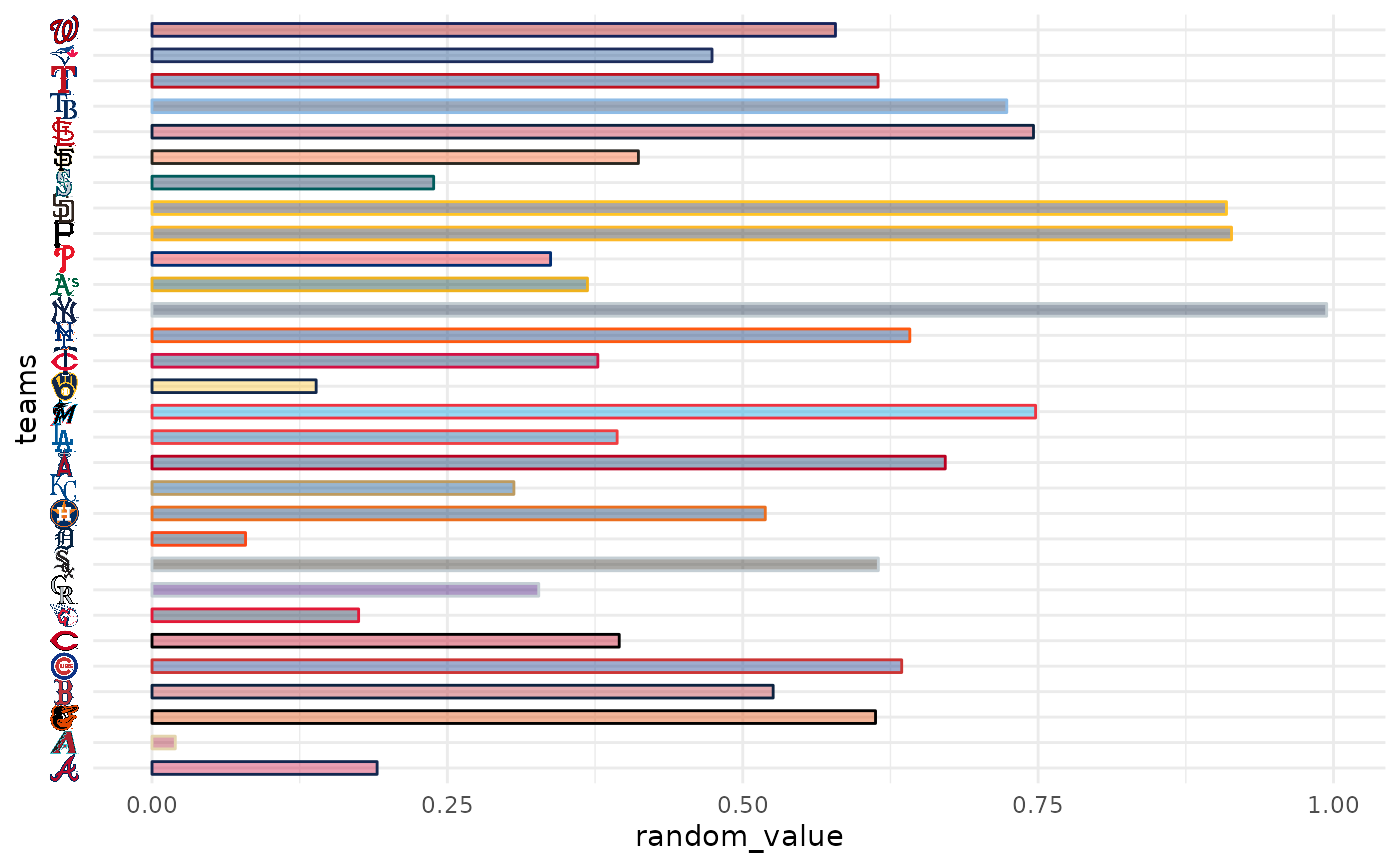scale_x_mlb() and scale_y_mlb() have been superceded in favor of element_*_logo() functions
These functions map MLB team names to their team logos and make
them available as axis labels
Arguments
- ...
Arguments passed on to
discrete_scalepaletteA palette function that when called with a single integer argument (the number of levels in the scale) returns the values that they should take (e.g.,
scales::pal_hue()).breaksOne of:
limitsOne of:
NULLto use the default scale valuesA character vector that defines possible values of the scale and their order
A function that accepts the existing (automatic) values and returns new ones. Also accepts rlang lambda function notation.
dropShould unused factor levels be omitted from the scale? The default,
TRUE, uses the levels that appear in the data;FALSEincludes the levels in the factor. Please note that to display every level in a legend, the layer should useshow.legend = TRUE.na.translateUnlike continuous scales, discrete scales can easily show missing values, and do so by default. If you want to remove missing values from a discrete scale, specify
na.translate = FALSE.na.valueIf
na.translate = TRUE, what aesthetic value should the missing values be displayed as? Does not apply to position scales whereNAis always placed at the far right.aestheticsThe names of the aesthetics that this scale works with.
labelsOne of:
NULLfor no labelswaiver()for the default labels computed by the transformation objectA character vector giving labels (must be same length as
breaks)An expression vector (must be the same length as breaks). See ?plotmath for details.
A function that takes the breaks as input and returns labels as output. Also accepts rlang lambda function notation.
callThe
callused to construct the scale for reporting messages.superThe super class to use for the constructed scale
- expand
For position scales, a vector of range expansion constants used to add some padding around the data to ensure that they are placed some distance away from the axes. Use the convenience function
expansion()to generate the values for theexpandargument. The defaults are to expand the scale by 5% on each side for continuous variables, and by 0.6 units on each side for discrete variables.- guide
A function used to create a guide or its name. See
guides()for more information.- position
For position scales, The position of the axis.
leftorrightfor y axes,toporbottomfor x axes.- size
The logo size in pixels. It is applied as height for an x-scale and as width for an y-scale.
Value
A discrete ggplot2 scale created with ggplot2::scale_x_discrete() or
ggplot2::scale_y_discrete().
Details
The scale translates MLB team abbreviations into raw image
html and places the html as axis labels. Because of the way ggplots are
constructed, it is necessary to adjust the ggplot2::theme() after calling this
scale. This can be done by calling theme_x_mlb() or theme_y_mlb()
or alternatively by manually changing the relevant axis.text to
ggtext::element_markdown(). However, this will only work if an underlying
dependency, "gridtext", is installed with a newer version than 0.1.4
Examples
# \donttest{
library(mlbplotR)
library(ggplot2)
team_abbr <- valid_team_names()
# remove league logos from this example
team_abbr <- team_abbr[!team_abbr %in% c("AL", "NL", "MLB")]
df <- data.frame(
random_value = runif(length(team_abbr), 0, 1),
teams = team_abbr
)
if (utils::packageVersion("gridtext") > "0.1.4"){
# use logos for x-axis
ggplot(df, aes(x = teams, y = random_value)) +
geom_col(aes(color = teams, fill = teams), width = 0.5) +
scale_color_mlb(type = "secondary") +
scale_fill_mlb(alpha = 0.4) +
scale_x_mlb() +
theme_minimal() +
# theme_*_mlb requires gridtext version > 0.1.4
theme_x_mlb()
# use logos for y-axis
ggplot(df, aes(y = teams, x = random_value)) +
geom_col(aes(color = teams, fill = teams), width = 0.5) +
scale_color_mlb(type = "secondary") +
scale_fill_mlb(alpha = 0.4) +
scale_y_mlb() +
theme_minimal() +
# theme_*_mlb requires gridtext version > 0.1.4
theme_y_mlb()
}
 # }
# }
